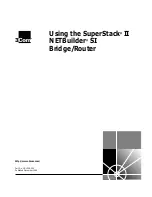
Chapter 3: System planning
148
approximately.
l
2 inches (or 5 cm) for 5.4 GHz and 5.8 GHz signals.
l
12 inches for 900 MHz signals
A reflected signal can arrive at the antenna of the receiver later than the non-reflected signal arrives. These
two or more signals cause the condition known as multipath. Multipath may increase or decrease the signal
level, resulting in overall attenuation that may be higher or lower than that caused by the link distance. This
is problematic at the margin of the link budget, where the standard operating margin (fade margin) may
be compromised.
Ob st r uct ions in t he Fr esnel Zone
The Fresnel (pronounced fre∙NEL) Zone is a three-dimensional volume around the line of sight of an
antenna transmission. Objects that penetrate this area can cause the received strength of the transmitted
signal to fade. Out-of-phase reflections and absorption of the signal result in signal cancellation.
The foliage of trees and plants in the Fresnel Zone can cause signal loss. Seasonal density, moisture
content of the foliage, and other factors such as wind may change the amount of loss. Plan to perform
frequent and regular link tests if you must transmit through foliage.
Planning f or co- locat ion
Co- locat ion bet w een O FDM ( 4 50 Series) and FSK ( PMP/ PTP 1x0 )
The first step to avoid interference in wireless systems is to set all AP/BHMs to receive timing from a
synchronization source (Cluster Management Module, or Universal Global Positioning System). This
ensures that the modules are in sync and start transmitting at the same time each frame.
The second step to avoid interference is to configure parameters on all AP/BHMs of the same frequency
band in proximity such that they have compatible transmit/receive ratios (all stop transmitting each frame
before any start receiving). This avoids the problem of one AP/BHM attempting to receive the signal from
a distant SM/BHS while a nearby AP/BHM transmits, which could overpower that signal.
Note
Refer to Frame Alignment Legacy Mode parameter of Configuration > Radio >
Advance tab for legacy product settings (See Configuration Guide).
The following parameters on the AP/BHM determine the transmit/receive ratio:
l
Downlink Data percentage
l
Frame Period
l
Max Range
l
(reserved) Contention slots
If OFDM (450 Platform Family) and FSK (PMP/PTP 1x0) APs/BHMs of the same frequency band and
channel bandwidth are in proximity, or if you want BHMs set to different parameters then you must use the
Frame Calculator to identify compatible settings for APs/BHMs.
The co-location is also supported for 900 MHz PMP 450i Series APs (OFDM) and PMP 100 Series APs
(FSK).
Содержание PMP 450 AP
Страница 92: ...Chapter 2 System hardware 92 Figure 29 MicroPoP Omni antenna implementation pattern Vertical ...
Страница 134: ...Chapter 3 System planning 134 Figure 51 Mast or tower installation ...
Страница 135: ...Chapter 3 System planning 135 Figure 52 Wall installation ...
Страница 136: ...Chapter 3 System planning 136 Figure 53 Roof installation ...
Страница 137: ...Chapter 3 System planning 137 Figure 54 GPS receiver wall installation ...
Страница 158: ...Chapter 3 System planning 158 Figure 61 cnMedusa Antenna ...
Страница 258: ...Chapter 5 Installation 258 Figure 123 Yagi antenna alignment horizontally Figure 124 Yagi antenna alignment upward tilt ...
















































